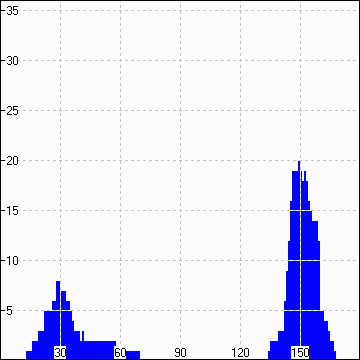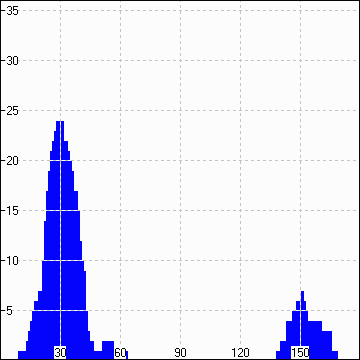
Are the Kracht/Marsden comets active?
As non-active, bare nuclei they should have been found already far from the sun. With apparent brightnesses of mag 5 - 8 at r = 0.05, d = 1, the brightnesses at r =1, d = 1 should be mag 11.5 - 14.5 (ignoring phase angles). It seems to be very improbable that about 60 objects of this kind have been gone unnoticed in earth based images until now.
Due to their low orbital inclinations and their small perihelion distances all Kracht/Marsden comets have been observed in SOHO LASCO C2 (with one exception - C/1996 V2, which crossed the C2 field when no images were taken). At superior conjunction they are observed under small phase angles, while at inferior conjunction the phase angles are large with a favourite condition for forward scattering, resulting in an increase in apparent brightness. Active comets should be found more numerous at inferior conjunction (at large phase angles).
To test this, I have plotted the phase angles of the observations of the Kracht/Marsden comets in the following way. For each comet a line is drawn from the smallest to the largest observed phase angle in C2. The phase angles are taken from M. Knight's data or computed by me for the most recent comets.

The Marsden group comets.
To the left (phase angles about 30 degree) are 10 Marsden comets
at superior conjunction.
To the right (phase angles about 150 degree) are 22 Marsden
comets at inferior conjunction.
Much more Marsden comets were observed at inferior than at
superior conjunction with the sun,
confirming that they are active, when observed in SOHO LASCO C2.

The Kracht group comets.
To the left (phase angles about 30 degree) are 26 Kracht comets
at superior conjunction.
To the right (phase angles about 150 degree) are 7 Kracht comets
at inferior conjunction.
Much more Kracht comets were observed at superior than at
inferior conjunction with the sun,
they are much less active than the Marsden comets, when observed
in SOHO LASCO C2,
but totally inactive nuclei would probabably be unvisible at
inferior conjunction.
The Kracht comets are thought to be dynamically older than the
Marsden comets, so it's not a
great surprise that they seem to be less active than the Marsden
comets.
Rainer Kracht, 2009 March 03
count of Marsden group comets in inferior/superior
conjunction corrected 2009 March 06